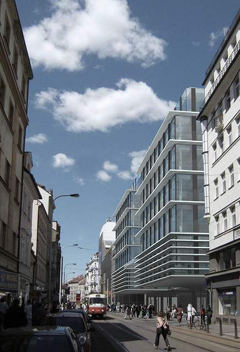
Archaeologists discovered well-preserved Gothic cellars at the National site
 |
According to Kalová, the Gothic cellars attest to the Gothic architecture near today's Spálená Street. The houses to which the cellars belonged were demolished in the late 1970s during the construction of the National Avenue metro station.
The archaeologists knew that cellars existed under the houses. However, they did not realize how much the metro construction had damaged them. They feared, for example, that the builders had filled them with concrete. "They have survived in their authentic state. There is no doubt that the uncovered objects represent a significant testament to the historical development of the area," Kalová stated.
The NPÚ staff managed to confirm the existence of cellars at the Tesco department store. "Therefore, it will be necessary to further negotiate with the investor about the next steps in the construction of the center," the NPÚ spokesperson emphasized.
Research over the National Avenue metro station began in August. Thanks to the excavations, the scientists have already managed to prove that settlement from the 12th century extended to this area at the border of the New and Old Towns. They also found tombstones from the now-defunct nearby Jewish cemetery in the foundations of demolished houses.
The local archaeological research is considered by NPÚ employees to be one of the most important excavations in the historical center of the city in recent years. In the Middle Ages, a settlement called Újezd near St. Martin was located close to the examined site, and a path from the Old Town to Vyšehrad also passed through here. Settlement may have existed along this path as early as the early Middle Ages. Archaeologists want to explore almost 3,500 square meters at the site, which is more than half of the entire building area.
The excavations at National Avenue are being compared by archaeologists to extensive research conducted under the Palladium shopping center at Republic Square. During this research, scientists discovered a ring, which as the oldest movable object demonstrates Jewish presence in the Prague agglomeration, as well as the foundations of luxurious non-stone houses or a stone Romanesque palace.
Remains of a Romanesque house were also uncovered by archaeologists in September during research at Prague Castle. Here, scientists have been investigating since the 1920s, and in recent years, for example, they uncovered the oldest fortifications of the castle promontory.
Among the 12 most significant research projects in Prague in recent years, archaeologists, according to Miroslava Šmolíková from the Museum of the Capital City of Prague, rank, for example, the Neolithic rondel from Prague's Ruzyně, which likely served as a cult center for the local settlement. They also consider the discovery of Celtic graves at Na Slupi, evidence of prehistoric settlement in Nová Liboc, or the finding of early medieval fortifications in Malá Strana to be very important.
The English translation is powered by AI tool. Switch to Czech to view the original text source.
0 comments
add comment
Related articles
0
02.06.2012 | The Gothic cellars near Národní třída will not be a monument
0
19.10.2011 | The ministry declared only part of the Gothic cellars as a monument
0
12.10.2011 | The ministry is set to make a decision on the Gothic cellars in the near future
0
13.04.2010 | The builder of COPA Center on Národní třída is in insolvency proceedings
0
31.03.2010 | The construction of the Copa Center on Národní is standing still, the investor owes money to the archaeologists






